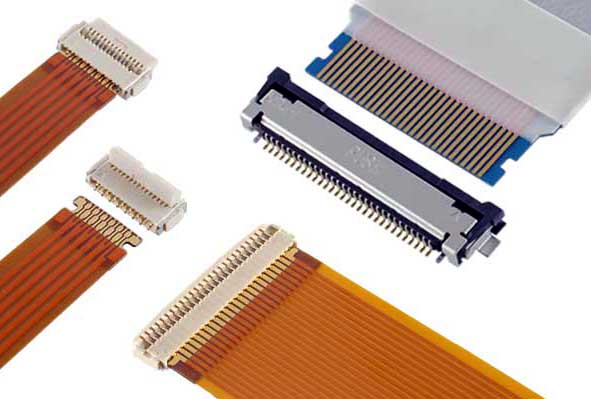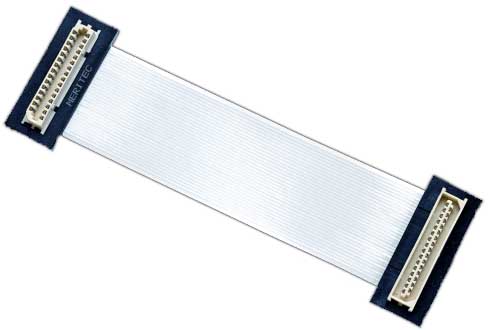The difference between FFC connector and FPC connector

The frequency of use of the connector is extremely high. In life, we have seen connectors more or less. For professionals, connectors are devices that need to be touched every day. In order to improve everyone's understanding of connectors, this article will explain the connectors from two aspects:
1. A brief introduction to the connector,
2. Introduce the difference between FFC connector and FPC connector and their common types.
First, Connector brief introduction
Also known as connectors, plugs and sockets in China. Generally refers to electrical connectors. That is to connect the components of two active devices to transmit current or signals.
The connector is a component that our electronic engineering and technical personnel often contact. Its role is very simple: Between the blocked or isolated circuits in the circuit, a bridge of communication is built, so that the current can flow and the circuit can realize the predetermined function. Connectors are an indispensable part of electronic equipment. Observing along the path of current flow, you will always find one or more connectors. Connector forms and structures are ever-changing. There are various types of connectors with different application objects, frequencies, power, and application environments. For example, the connectors for lighting on the court are very different from the connectors for hard drives, and the connectors for lighting rockets. But no matter what kind of connector, it is necessary to ensure that the current flows smoothly, continuously and reliably. In general terms, what the connector is connected to is not limited to current. In today's rapid development of optoelectronic technology, in the optical fiber system, the carrier of the signal is light. Glass and plastic replace the wires in ordinary circuits, but connectors are also used in optical signal paths, and their functions are the same as circuit connectors. Since we only care about circuit connectors, this course will closely integrate Molex's products, focusing on circuit connectors and their applications.

two, The difference and common types of FFC connector and FPC connector
Today's connector forms and structures are ever-changing, and there are various types of connectors with different application objects, frequencies, power, and application environments. The FFC connector is a flexible flat cable connector. It is a new type of data cable made of PET insulation material and extremely thin tinned flat copper wire, laminated through a production line of high-tech automated equipment. It has soft, free bending and folding, thin thickness, small size, simple connection, convenient disassembly, and easy to solve electromagnetic shielding (EMI). The following mainly talks about the difference between FFC connector and FPC connector, and the commonly used types of FFC connector.
1. The difference between FFC connector and FPC connector
The FFC connector is a flexible flat cable connector, and the FPC connector is a flexible printed circuit. Speaking from the manufacturing of their two connectors, the way their lines are formed is different:
a. FFC is a flat copper foil sandwiched between upper and lower insulating foil films. The finished product is simpler and thicker.
b. FPC is to process FCCL (flexible copper clad foil) by chemical etching to obtain flexible circuit boards with different single-sided double-sided and multilayer structures.
In terms of price, naturally FFC connectors are much cheaper. If the production cost is taken into consideration, more companies will like to use the related design of FFC connector.
2. 7 common types of FFC connectors
Type A: Both ends are connected and the reinforcing plate is pasted on the insulating tape;
Type B: Cross the reinforcing plate and paste it directly on the insulating tape;
Type C: The reinforcing plates at both ends are directly pasted on the conductor;
Type D: Cross the reinforcing plates at both ends and paste directly on the conductor;
Type E: one end of the reinforcing plate is attached to the insulating tape, and the other end is directly soldered;
Type F: The reinforcing plates at both ends are directly attached to the insulating tape, and the inner half is peeled off;
Type G: Direct soldering at both ends.
In terms of price, naturally FFC connectors are much cheaper. If the production cost is taken into consideration, more companies will like to use the related design of FFC connector.
2. 7 common types of FFC connectors
Type A: Both ends are connected and the reinforcing plate is pasted on the insulating tape;
Type B: Cross the reinforcing plate and paste it directly on the insulating tape;
Type C: The reinforcing plates at both ends are directly pasted on the conductor;
Type D: Cross the reinforcing plates at both ends and paste directly on the conductor;
Type E: one end of the reinforcing plate is attached to the insulating tape, and the other end is directly soldered;
Type F: The reinforcing plates at both ends are directly attached to the insulating tape, and the inner half is peeled off;
Type G: Direct soldering at both ends.
In general, the development of today's FFC connector technology has the following characteristics: High-speed and digitization of signal transmission, integration of various signal transmissions, miniaturization and miniaturization of product volume, low-cost products, surface-mounting of contact termination methods, modular combination, convenient insertion and removal, etc





